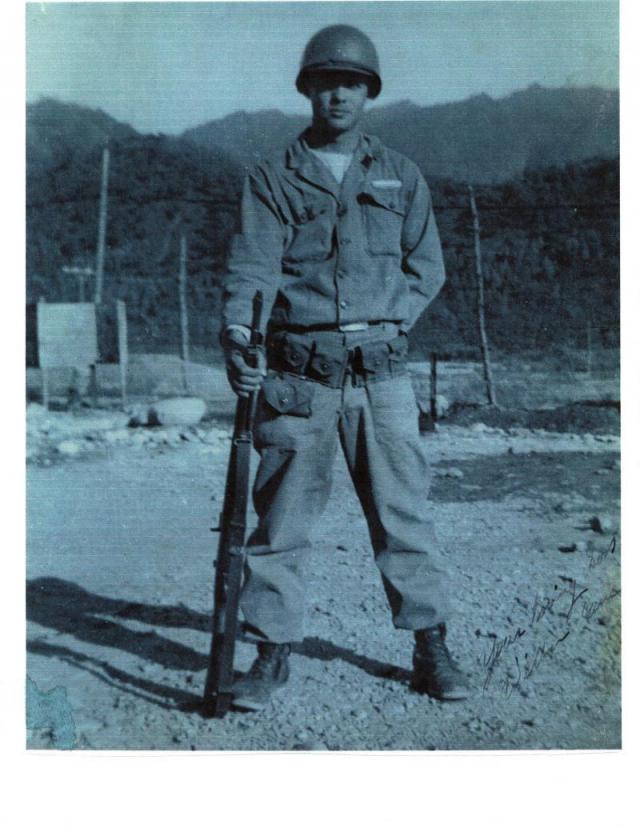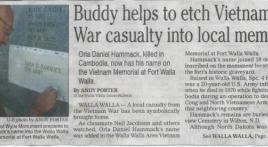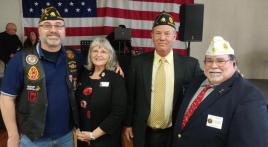I was in the 11th grade when on Jan. 19, 1951, some friends and I went over to Jacksonville, Fla., and enlisted in the Regular Army. That was four months before I was 17. My mother had no problem with this because I was still running around with the wrong crowd, she said. My records showed I was 18, as I had used the same birth certificate I used to enlist in the NG the year before. We were sent for basic training to Fort Jackson, S.C. I trained with the 28th FA Battalion, 8th Division located on Tank Hill. I was assigned as a platoon guide (because of my NG experience) until I caught pneumonia and was in the hospital for a couple of weeks and had to change training companies. In the new company I was just one of the trainees as the Acting Jack (what we called them) positions were already assigned. I finished basic training in May 1951 and was given a two-week leave and ordered to report to Fort Lawton, Wash., for transport to Japan.
From my leave I proceeded by train from Jacksonville to Fort Lawton, where after a few days I was shipped via troop ship to Japan arriving in July 1951. I was then sent to a pole line construction course on Eta Jima (an Island), Japan, for four weeks' training. Why I was sent there I have no idea because when I completed the training I never climbed another pole. From Eta Jima I was sent to Sasebo, Japan, and from there to Pusan, Korea, via Japanese fishing trawler. It was early August 1951.
After a few days in Pusan several hundred of us were loaded on a train and moved up to the 2nd Infantry Division. Here we were lined up, dressed right dressed, covered down and divided up into three groups. One group for each of the infantry regiments. That’s how I was assigned to the 1st Battalion, 38th Infantry Regiment. Not by name but by where I was standing. No one asked what our MOS was, so regardless of our training we were all assigned to the infantry. I later learned that the 2nd Division had recently had some serious losses due to both combat and rotation. We gave someone our names as we were loaded onto trucks for transport to the battalions. At the battalion we were given a hot meal, and while waiting in line I overheard a couple of old-timers say that Company “C” did a lot of fighting but had few casualties. That appealed to me, so the next morning we were all asked if we had a preference insofar as the company we wanted to be assigned to. They said this was to let buddies go to the same company if they wanted to. I chose Company “C”. After arrival at the company I found out that they were in bad need of replacements because they had suffered serious casualties recently. I think they had also recently been strafed by our own planes. It did dawn on me that the chow line conversation had been a set-up to get volunteers for the company. My squad leader, called “Frenchie”, assigned me the Browning Automatic Rifle (BAR). The weapon and the ammo belt seem to weigh as much as I did. He explained that it was routine to assign the weapon to the “new guy.” My first night on the line while on watch, I thought I kept seeing movement to our front. But I guess it was a combination of nerves, being awake by myself and scared, because the next morning I saw that it was only terrain formations, bushes and trees. On Aug. 29 we were ordered to move to an assault position behind another unit. It was during this move that I saw my first couple of U.S. dead on the side of the trail we were moving along. Early on the morning of the 30th we moved through the front-line positions to attack a Chinese-occupied hill to their front. Frenchie, my squad leader, did not go with us as he was ordered to the rear for rotation. Shortly after departure from the friendly line I saw Chinese bodies all over the place. Evidently there had been a hell of a firefight a couple of days before. Anyway, as we moved forward we found that the Chinese were also moving to attack us. We met in draw and slugged it out for that day. Both sides withdrew and returned to their lines. Company “C” could only muster 19 at the end of the day and I had the only automatic weapon, the BAR. We spent the night behind the front-line bunkers using them as shields. The bunker I was behind received a direct hit, which blew the roof off and wounded those inside but did not touch us who were behind the bunker. We were ordered to resume the attack on the 31st. Before jumping off we heard that on the way to the rear Frenchie had accidentally set off a trip flare and that it caught him in the groin area and he bled to death. We succeeded in our attack and I had gotten almost to the top of the hill when a Chinese soldier jumped up out of a bunker about 30 feet from me. He was firing a burp gun, the kind with the drum-type ammo magazine, and I got hit in the side of my chest. The bullet knocked me down and drained me of all my energy. My right lung was punctured and air bubbles were coming out when I breathed. Just before dark a litter team moved me down the hill and back to the battalion aid station. It was dark and I was placed in a bunker without being attended to. The next morning, Sept. 1, I was given a shot of morphine and carried down the hill to an ambulance and then to a medevac hospital, arriving on Sept. 2. I was operated on and held there for a few days, being frequently given shots of morphine. That entire stay was just a haze – I remember very little except a doctor trying to explain to me the operation he had to do and asked for my permission. I told him to just do what he had to do to stop the pain. I was flown from Korea to Japan and the Tokyo Army General Hospital. The first thing they did was stop completely the morphine shots, and that caused me some mental anguish for a few days going through withdrawal. This was where they sewed me up. I was wide open from underneath my right shoulder blade to the middle of my stomach until then. They were trying to be sure I did not become infected.
Following my stay in the hospital I was sent to Camp Drake, Japan, for rehabilitation and then returned to the United States via troop ship. After leave I reported in to Fort Rucker, Ala., where I was placed on light duty and assigned first as a jeep driver - until I almost turned it over with my commanding officer in it, then they gave me a 2 ½ ton truck to drive. The division (it was a mobilized Minnesota National Guard division) was going to Korea and I was reassigned to Fort Benning, Ga., as a sedan driver in the 27th Transportation Car Company. I made friends with a personnel clerk and was able to get on orders back to Korea. I served from May 13, 1952, until September 20, 1953, as the NCOIC of the 179th Infantry Regiment Postal Unit as a sergeant E-5.. One day while riding shotgun on a mail truck from the rear area to the front I witnessed one of our jet fighters shoot down a Chinese jet. It was fairly low and they were almost directly over us. At first it looked like our plane was trying to get the enemy plane to land, but the end result was one enemy plane shot down.
When I finished my second tour in Korea I returned to the States to continue my 22-year military career, eventually becoming an infantry officer and then going on to Vietnam for 3 tours (’66-’68), becoming wounded in two of them. I retired as a major in July 1972 at 38.
Note: Maj (R) Wilbur G. Corbitt passed away in September 2021 at age 87.




